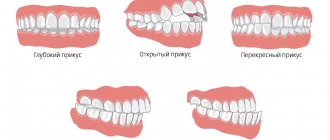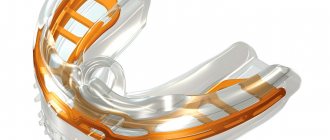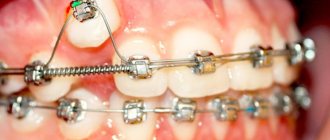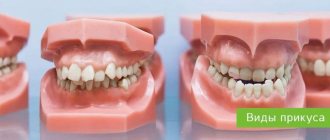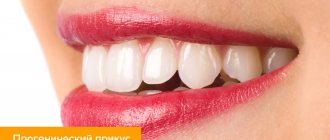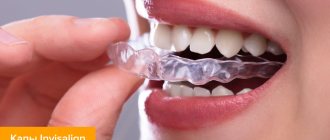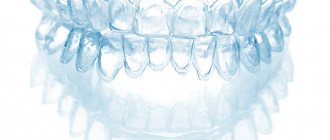When the upper and lower jaws close, the dentition interacts with each other in a special way. This interaction is called "bite". How correctly the dentofacial apparatus functions depends on the nature of the closure of the dentition.
A normal or physiological bite ensures the high-quality functioning of the dental system. A person with a normal bite has clear diction, free breathing, and an attractive smile.
Pathological occlusion is a serious deviation in which the functioning of the masticatory muscles and the temporomandibular joint is impaired. As a result, the patient feels discomfort when chewing food, his teeth deteriorate, his appearance deteriorates, and his quality of life is disrupted.
In order to describe the types of disorders in the structure of the dentofacial apparatus, a classification of occlusions is carried out. There are three degrees in dentistry.
- The first degree assumes a normal or physiological bite. The main signs of a normal bite: there are no pronounced gaps between the closed upper and lower teeth, their contact occurs symmetrically, the central line of the jaws coincides with the midline of the face.
- The second and third degrees indicate the presence of deviations from the norm of varying intensity.
There are different types of normal and pathological occlusion.
Types of normal occlusion
According to statistics, no more than 30% of the population have a normal bite. There are several types of teeth arrangement that meet all the signs of a correct bite:
- Orthognathic. The teeth of the upper jaw overlap the lower teeth by a third of the crown size. When the jaws close, close contact occurs between the teeth.
- Straight. The cutting edges of the upper and lower teeth are in close contact. Correct occlusion of molars and premolars is mandatory.
- Biprognathic. The upper and lower incisors have a slight inclination towards the vestibule of the mouth. There is contact between the incisors, and the upper canines slightly overlap the lower ones.
- Progenic. The teeth of the lower jaw are pushed forward relative to the upper ones. The closure is maintained.
With any type of normal positioning of teeth, bite correction is not carried out, since the load on the teeth is carried out evenly. Food is chewed thoroughly, the temporomandibular joint is not overloaded.
general information
In dentistry, types of occlusion refer to the position of the teeth in the mouth when the jaws meet. This contact is called occlusion. Central occlusion is when the teeth meet at most points, the head of the mandible is at the base of the articular tubercle, and the middle of the face should correspond to the passing line between the main incisors.
Normal (physiological) types of occlusion include:
- straight;
- orthognathic;
- biprognathic;
- progenic.
Each of them has its own characteristics. Violations can be determined at home. An exemplary closure is considered to be the option when the upper row of teeth overlaps the lower ones by no more than a third. The contact itself is tight. In addition, the shape and size of the teeth are taken into account. The upper jaw is characterized by a slight inclination towards the lips, and the lower jaw - towards the tongue.
Types of abnormal bite
Any type of abnormal bite is characterized by the presence of gaps between the teeth of the upper and lower jaw. Lack of contact creates problems when chewing food, diction is impaired, and the oval of the face changes.
- Open is characterized by the presence of areas of non-closure in the anterior or lateral areas of the dentition. It is manifested by the presence of a gap between the teeth of the upper and lower jaw, non-closure of the lips, leading to disruption of the functions of chewing, breathing, and diction.
- Deep . The teeth of the upper dentition overlap the lower ones by more than 30% of the crown height. The most common type of abnormal bite. A strong degree of pathology leads to constant trauma to the mucous membrane of the gums, which is why this type of bite is called traumatic.
- Distal . It is characterized by protrusion of the upper dentition in relation to the lower one due to abnormal development of the upper jaw (or underdevelopment of the lower jaw). External signs are a sloping chin, shortening of the upper lip and retraction of the lower lip. The upper and lower incisors do not have contact, and the lateral ones do not close correctly.
- Cross is characterized by the crossing of the dentition when closing. Characteristic signs are facial asymmetry as a result of uneven development of the jaw areas. The patient complains of diction defects, accidental biting of the inner cheeks and pain when chewing.
- Mesial . It is characterized by the advancement of the lower dentition as a result of underdevelopment of the upper jaw or abnormal development of the lower jaw. Poor contact between the teeth of the lower and upper jaw leads to dysfunction of chewing and speech. Externally, the anomaly is manifested by the presence of a massive chin, a receding upper lip, and a concave face profile.
Dividing each type of abnormal bite into separate subcategories helps determine the degree and nature of the pathology.
If there are even minimal deviations, you should consult an orthodontist for advice. Pathology of the dentofacial apparatus has a tendency to progress and develop complications from the gastrointestinal tract.
What kind of bite is there?
By the nature of the interaction of the teeth of the upper and lower rows at the time of central occlusion, various bite options are determined.
A person
may have a bite:
- Physiological or correct.
- Malocclusion.
Signs of correct teeth alignment:
- The upper row of teeth overlaps the lower ones by about one third.
- Clear interaction of antagonist teeth with each other.
- Lack of spaces between teeth.
- The midline of the face passes between the central incisors of the dentition.
- No disturbances in the chewing function of teeth and speech.
Causes of pathological bite
The formation of occlusion is a long and complex process that begins at the stage of intrauterine development, continues in early childhood and ends after the end of puberty. Pathological occlusion is the result of long-term influence of a number of unfavorable external or internal factors at different periods of a person’s life:
- Genetic factor. A genetically determined anomaly is formed when there is a congenital discrepancy in the size of the teeth and dentofacial bones (crowding of teeth or the presence of spaces between teeth) or a hereditarily determined abnormal shape and size of the lower and upper jaws.
- The influence of negative factors on the body of a pregnant woman. The formation of the dental apparatus in the fetus can be influenced by bad habits, poor nutrition and diseases suffered by a woman during pregnancy.
- Birth injury. During childbirth, the baby may receive injuries leading to displacement of the temporomandibular joint.
- Negative factors affecting the baby’s body in the first years of life. The reason for the formation of a distal bite may be the incorrect selection of nipples or the late introduction of solid foods into the diet.
- Bad habits and behavioral factors in early childhood. The habit of sucking a pacifier or finger, or sleeping with the head thrown back can cause a child to develop a deep bite.
- Factors influencing the formation of anomalies in later life. These include carious lesions of the teeth, ENT pathologies, deviated nasal septum, and diseases of the skeletal system.
Treatment of abnormal bite should begin as early as possible. Early diagnosis and therapy make it possible to restore the normal functioning of the dentofacial apparatus more effectively. Doctors at the Consilium-Dent use specially developed diagnostic tests and tables. They are used both for direct examination of the oral cavity and for diagnosis using dental casts.
The need for a particular therapeutic measure is determined by a specialist based on the diagnostic results on an individual basis. You cannot resort to self-medication in this situation. This can lead to activation of the pathological process.
Correct closure of teeth: formation stage
The formation of the bite occurs from the first days after birth and lasts until adolescence, on average up to 16 years. The stage begins with the appearance of the first incisors. After replacing all primary dental elements with permanent ones, the bite is determined. Its development is influenced not only by external factors, but also by the form of heredity.
Bad habits that contribute to malocclusion
To avoid malocclusion, the following rules must be followed as a precaution:
- Teeth bite is correct and incorrect - what it should be and how to eliminate anomalies
- Breastfeeding from birth is considered beneficial.
- Try not to give your child rubber nipples or objects of a similar nature.
- If this occurs, wean your child from sucking fingers or toys.
- The child's sleep should be calm, his breathing should be even through the nasal cavity, his mouth should be closed.
- Visit doctors specializing in the oral cavity in a timely manner; it is the dentist who is able to identify pathology in time, eliminate defects, prescribe the correct treatment, or give preventive advice.
It is important to know! Primary incisors must be replaced by permanent ones, strictly in this sequence. If the permanent incisors occupy niches along with the deciduous ones, this is considered unacceptable.
Correcting malocclusion
There is a danger of teeth transitioning from a normal state to malocclusion, which occurs against the background of maxillofacial injuries, due to gum disease, unprofessional prosthetic work, as well as due to the loss of teeth and their prolonged absence.
Video: What determines the formation of a correct bite
Common types of malocclusions
The most common anomalies of the dental system include deep bite. A severe degree of pathology is characterized by a situation where the upper row of teeth completely overlaps the lower row. When the jaws are closed, the upper incisors can injure the mucous membrane of the lower gums. Therefore, this type of anomaly is called a traumatic bite.
A deep bite is accompanied by a violation of facial aesthetics, impaired diction, poor quality of chewing food, and increased abrasion of the enamel.
There are two degrees of development of pathology. They are caused by various provoking factors and are characterized by different forms of manifestation:
- Primary deep bite is often due to genetic reasons and is determined by the special structure of the facial bones. It manifests itself as pathological changes in the area of the dentition, alveolar process and basal part of the jaws. The movement of the jaws is blocked, and the patient experiences significant discomfort when chewing.
- Secondary deep bite is acquired in nature and is a consequence of a disease or injury. As a result of a decrease in the interalveolar distance and the lower third of the face, a deep traumatic closure of the incisors develops.
Another type of pathology classification is carried out depending on the nature of the interaction of the lateral teeth.
- A deep distal bite is characterized by the overlap of the lower row of teeth with the upper ones by more than one third of the length of the crown with a violation of the relationship of the lateral teeth. Characteristic disorders include difficulty biting and chewing, breathing problems, and pain in the temporomandibular joint.
- Deep neutral bite: when the overlap of the lower front teeth with the upper ones is disturbed, while the position of the lateral teeth is not disturbed.
If you experience even minor discomfort when chewing, you should immediately contact a specialist and follow his recommendations.
The presence of a malocclusion or a predisposition to it is determined by an orthodontist after an initial examination using special tests. Self-diagnosis does not provide an objective picture of the condition of the dentofacial apparatus, since different pathologies may have the same symptoms. Treatment in this case will be radically different.
If there are no problems with your bite, you should visit the orthodontist for a preventive examination approximately once every six months. The doctor will determine whether there is a tendency to a particular anomaly even before the problem is noticeable.
Consequences of malocclusion
All types of malocclusion cause a complex of problems, both dental and more general:
- the development of caries and gingivitis is caused by ineffective oral hygiene. Even with regular and thorough brushing of teeth, due to malocclusion, hard-to-reach areas remain where food debris accumulates and bacteria multiply;
- accelerated tooth decay, abrasion and chipping of enamel - caused by uneven load on the teeth;
- disorders of the gastrointestinal tract that occur due to insufficient chewing of food;
- diseases of the respiratory system due to improper development of the dental system;
- problems with the TMJ, causing pain in the head, ears, back, overstrain of the facial muscles, bruxism, poor posture, etc.;
- violations of facial aesthetics: asymmetry, nasolabial folds, sagging skin of the chin and neck - these and other defects caused by malocclusion can be effectively corrected only with the coordinated work of a cosmetologist and an orthodontist.
Need some advice?
Enter your phone number and we will give you a free consultation
I want a consultation
*By making an appointment you consent to the processing of your data
The importance of routine observations in normal occlusion
In children with an orthognathic or straight bite, the arrangement of dental units in a row may change due to untimely (early or late) change of primary teeth. During a preventive examination, the orthodontist will identify the presence of abnormalities in the rudiment itself. The following types of preventive measures are carried out:
- Clinical examination (allows us to identify existing anomalies and risk factors).
- Formation of groups of patients for further clinical observation.
- Drawing up a plan of preventive and therapeutic measures (pediatricians of all profiles participate).
In adult patients with normal dentition, malocclusion can develop under the influence of external and internal unfavorable factors. The main reasons that increase the risk of developing dental anomalies in adults are:
- carious process;
- loss of teeth;
- various types of prosthetics;
- prosthetics errors;
- bad habits.
During the examination, the dentist will identify the presence of predisposing factors, after which he will develop a scheme for carrying out preventive measures to maintain a normal bite. Selection is carried out on an individual basis, taking into account the condition of the dental system and the physiological characteristics of the patient’s body.
Consequences
The influence of bite on the condition of the dental system and the entire body is enormous.
Bite pathologies lead to:
- Loss of teeth. Uneven chewing load leads to cracks and chips. Bacteria penetrate through the damaged enamel layer, affecting periodontal tissue. Periodontitis develops. Teeth become loose and fall out. The risk of caries in such cases is higher than in people without defects.
- Disorders of the temporomandibular joint (TMJ). It begins to click, hurt, and in severe cases, dislocation is possible.
- Due to crowded teeth, plaque and tartar quickly form, which provokes gingivitis and periodontitis.
- Insufficient contact between teeth leads to food being poorly chewed. As a result, problems arise with the gastrointestinal tract.
- Oral, impaired breathing causes diseases of the respiratory system.
- The position of the jaws affects posture. An abnormal movement of the jaw forward shifts the center of gravity, the position of the neck changes, the chest collapses, and the person begins to stoop. Muscle tone is impaired and back pain begins.
- An incorrect bite distorts facial features and disrupts its symmetry.
Anomalies of the jaws affect the psychological state. The person withdraws into himself and avoids company. Depressive states are common.
Orthodontic treatment restores physical and emotional balance and helps improve self-esteem.
Treatment of malocclusions
Before prescribing treatment procedures, the orthodontist assesses the condition of the oral cavity, carefully examines the depth of the problem and the presence of concomitant pathologies, taking into account the patient’s age. Treatment of dental anomalies is carried out using conservative and radical methods:
- Braces are the most popular method of bite correction. This orthodontic method has the widest range of applications and is suitable for solving any problem of malocclusion. Treatment with this method is long and includes preparatory, main and retention (recovery) periods.
- Aligners. Removable structures are used to treat the initial stages of deviation. With their help, a gentle correction of the dentoalveolar apparatus is carried out, changing one set of mouthguards to another.
- Application of veneers, onlays, crowns. Weak areas of the dentition that are susceptible to caries are protected by using orthopedic structures. Chipped areas of enamel are restored using ceramic onlays and veneers.
- Surgical intervention is performed to treat late stages of dental anomalies (mainly of a hereditary nature). During the operation, the position of the jaws is changed, their size is reduced or increased.
Laser therapy is performed as an auxiliary treatment to help speed up regeneration and reduce the risk of complications.
Types of prevention of malocclusions
Prevention of malocclusion in childhood is very important, as it determines whether the child will have problems in the future. Adults should monitor the eruption of permanent teeth in children and visit an orthodontist with the child for timely detection of anomalies and bite correction.
Prevention of malocclusions involves eliminating bad habits that cause one or another anomaly: lip biting, finger sucking in children. To do this, special plates are used that block the ability to use a bad habit. In adults, such methods help cure abnormalities in the early stages.
It is important to carry out sanitation of the oral cavity in a timely manner and periodically come for medical examinations to the dentist. Children from the age of six months should be taught to chew solid food.
A good method of prevention is specially designed therapeutic exercises. When performing exercises, the patient puts the correct load on the jaw muscles, which contributes to the harmonious development of the maxillofacial system.
Bite formation in children
At the stage of bite formation in children, there are three most important periods:
- The milk bite begins to form at six months of age and continues until 3 years of age. This is the initial stage during which the foundation for the formation of a permanent bite is laid.
- The change to a permanent dentition lasts up to 9 years. During this period, the jaws actively develop and a permanent bite begins to form. During this period, when the dentition consists of baby and permanent teeth, children often develop malocclusions. Common causes are a violation of the pairing of teeth erupting with an unequal degree of development of the jaw sections.
- The formation of a permanent bite occurs from 12 to 15 years. The replacement of baby teeth ends, permanent teeth complete their growth and are installed in their permanent places.
Prevention of malocclusion in childhood is very important, as it determines whether the child will have problems in the future. Adults should monitor the eruption of permanent teeth in children and visit an orthodontist with the child for timely detection of anomalies and bite correction.
Straight bite
Direct or orthogenic bite is distinguished as a separate type, since it is not a pathology, but is not the norm either. Experts have differing opinions on this matter. In direct occlusion, the upper incisors close tightly over the lower ones. This type is characterized by the following characteristics:
- absence of visual imbalances;
- no gaps between dental rows;
- general aesthetic appearance of the smile;
- there are no jaw elements protruding forward.
This smile looks almost perfect and can be considered a standard. But constant contact of the upper and lower incisors provokes a number of problems, in particular, intense wear of the teeth, and therefore the height of the crowns decreases.
Other problems of orthogenic occlusion are considered to be an increased risk of caries, dysfunction of the temporomandibular joint, and bruxism.
It is not always possible to determine the type of occlusion only by visual signs. Sometimes only a specialist can identify deviations from the norm. But in any case, occlusion anomalies must be corrected so that they do not lead to more serious consequences.

